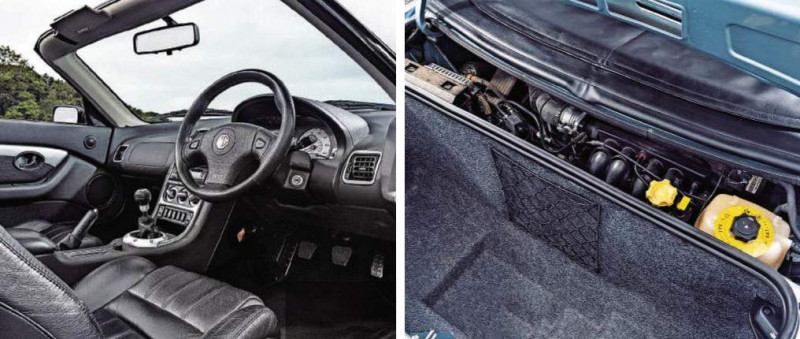2000 MGF 1.8i
While the MX-5 was under secret development at Mazda, over in Longbridge MG was looking to the future. Antiquated Sixties-rooted sports cars had given way to hot hatches, but Roy Axe’s design team was tasked with dreaming up a halo model to reintroduce the idea of an MG sports car to the buying public.
What resulted was the 1985 EX-E, a mid-engined, four-wheel drive V6 supercar concept based on the Metro 6R4 Group B rally car, which could have taken MG toe-to-toe with Ferrari had it gone into production. It was deemed to be too expensive for an MG, but stylist Gerry McGovern evolved it into something smaller, simpler and more affordable, yet still mid-engined. Management scratched its head, but once the MX-5 had proven wildly successful, the MGF – named after the F16 Falcon fighter jet from which McGovern drew inspiration – was enthusiastically given the green light.
I’m taken back to September 1995 and my first day at secondary school when I slide into the driving seat of this MGF. Not because I sat in one then, but because of the euphoria it generated upon launch. It embodied the Sixties-tinged but resolutely modern mentality that ‘Cool Britannia’ popular culture oozed back then. Its launch made the mainstream newspapers. Kids talked about them in playgrounds. A friend of mine entered a prize draw to win one by collecting and posting crisp packets. He was 11 at the time, and that memory sums up these cars for me – every patriotic British car enthusiast wanted one even if they couldn’t drive. Second-hand examples were more expensive than new ones well into 1996, such was the demand, and for a while the MGF comfortably outsold the MX-5 in the UK.
There’s a hint of TVR in the way the interior’s sculptings sweep and curve around its occupants. That, and the exterior styling aft of the doors, where we see the main aspects of the EX-E to survive into the F. The driving position is nicely relaxed and reclined, although the pedals are all but invisible beneath the chunky dashboard, and descend in an awkward manner that strains my ankles.
Its driving style couldn’t be more different from its Mazda rival.
There’s an overly damped and isolated feel to the pedals, steering wheel and gearchange that makes it feel imprecise at first, and while the 1.8-litre Rover K-series engine gives an intoxicating growl, it’s quiet and well insulated. But put faith in the F and it rewards. Hydragas suspension means it remains eerily level through slalom manoevres, like Nigel Mansell’s 1992 active-suspension Williams F1 car, and that sense of insulation makes such things effortless. As a result, the overall impression is one of urbane sophistication, something that makes the MG seem more grown-up and GT-like than the MX-5. The boot is bigger than you might expect (although the result is woeful engine access), and it’s easy to imagine taking a long cross-country drive in the F, casting it in the mould of a sort-of modernised, British Matra Murena or a downsized Dino.
Like the Mazda, there’s no threat of oversteer when pressing hard into corners (if anything there’s more understeer, odd for a car with not much nose-weight) but catch it on a pothole mid-corner and those Hydragas spheres will set it bouncing like an old Mini. Build quality is excellent, and they’re far more impervious to rot than an MX-5, but unfortunately that sweet-revving K-series has design flaws that cannot be overlooked. Designed as a 1.1 to 1.4-litre engine, its 1.6 and 1.8-litre bores were a step too far for the block, reducing the size of the coolant jacket. All it takes is a small leak or the coolant momentarily running low for it to overheat, blow the head gasket and warp the cylinder head, an issue made worse by the use of plastic through-bolts that had a tendency to snap, or stretch causing the head gasket to ‘float’, and also the original silicon gasket itself perishing when heated. You can mitigate against this by fitting an upgraded multi-layer steel gasket from a Land Rover Freelander, and a low coolant warning system, for £150 and £130 respectively. That said, attention to coolant levels will make the difference between a K-series living or dying.
Fear of the gasket-failure issue, plus the loss of MG from 2006- 2011, kept prices for MGFs rock-bottom for years and helped to thin the herd. During that time though, the peerless MG Owners’ Club has embraced them and they’re as well-supported as the ’B. Hydragas spheres, for years irreplaceable, are now available again. As a result, prices for decent MGFs mirror MX-5s, with 1.6s cheaper than 1.8s, viable projects starting at £1k, and most settling between £1.5k and £3.5k. There are bargains though; we found a 1.6 with head gasket upgrade in Northern Ireland for £1k, for example. And of course there’s the 159bhp VVC, typically £5k-plus, although we found one in Hampshire for £3995, in iconic Trophy Yellow too.
Owning an MGF
Frank Clemmey comes from a family of serial MG-buying enthusiasts which has been home to this rare Wedgewood Blue MGF 1.8 SE since it was new in 2000. ‘My son Nick bought it new, although recently it’s spent many years in storage before being recomissioned during lockdown. That has probably helped maintain its condition, and it’ll no doubt see a lot more regular use while we overhaul our next project – a rare Downton MGC. ‘Touch wood, it’s been reliable, although that’s possibly down to keeping to the original maintenance schedule and not always running it as a daily driver. Although they were actually very well made (they’re not rust prone) there’s no getting away from the head gasket issue, and it’s worse in the MGF because the radiator is at the opposite end of the car to the engine, and the pipes under the car are vulnerable to cracking and leaking. But technology exists to keep on top of it now, and these cars are very well supported by the MGOC.’
2000 MGF 1.8i
- Engine 1795cc transverse four-cylinder, dohc, MEMS MPI electronic fuel injection
- Max Power 120bhp @ 5500rpm
- Max Torque 118lb ft @ 4000rpm
- Transmission Five-speed manual, rear-wheel drive
- Steering Electrically-assisted rack-and-pinion
- Suspension Front and rear: independent, double wishbones, Hydragas spheres, telescopic dampers, anti-roll bar
- Brakes Servo-assisted discs front and rear
- Weight 1320kg
- Performance Top speed: 120mph;
- 0-60mph: 8.6sec
- Fuel consumption 38mpg
- Cost new £17,995
- Classic Cars Price Guide £800-£3000

Ease of engine access is hardly an MGF strong-suit… A comfy and sporty cockpit, despite slightly odd seating position.
‘In the MGF, the overall impression is one of urbane sophistication’


